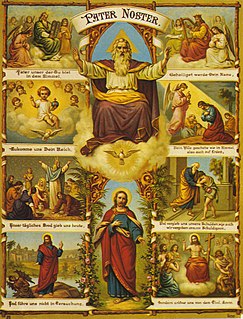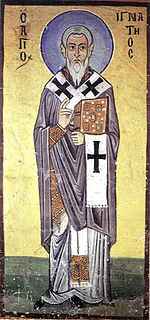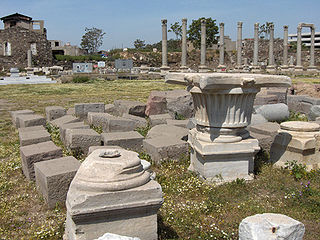The word catholic comes from the Greek phrase καθόλου (katholou), meaning "on the whole", "according to the whole" or "in general", and is a combination of the Greek words κατά meaning "about" and ὅλος meaning "whole". The term Catholic was first used in the early 2nd century to indicate Christendom as a whole. In the context of Christian ecclesiology, it has a rich history and several usages.

Polycarp was a 2nd-century Christian bishop of Smyrna. According to the Martyrdom of Polycarp he died a martyr, bound and burned at the stake, then stabbed when the fire failed to touch him. Polycarp is regarded as a saint and Church Father in the Eastern Orthodox, Oriental Orthodox, Catholic, Anglican, and Lutheran churches. His name 'Polycarp' means 'much fruit' in Greek.

The Last Supper is the final meal that, in the Gospel accounts, Jesus shared with his Apostles in Jerusalem before his crucifixion. The Last Supper is commemorated by Christians especially on Maundy Thursday. The Last Supper provides the scriptural basis for the Eucharist, also known as "Holy Communion" or "The Lord's Supper".

Transubstantiation is, according to the teachings of the Roman Catholic Church, the change of substance or essence by which the bread and wine offered in the sacrifice of the sacrament of the Eucharist during the Mass, become, in reality, the body and blood of Jesus Christ.
In the New Testament, a presbyter is a leader of a local Christian congregation. The word derives from the Greek presbyteros, which means elder or senior. The Greek word episkopos literally means overseer; it refers exclusively to the office of bishop. Many understand presbyteros to refer to the bishop functioning as overseer. In modern Catholic and Orthodox usage, presbyter is distinct from bishop and synonymous with priest. In predominant Protestant usage, presbyter does not refer to a member of a distinctive priesthood called priests, but rather to a minister, pastor, or elder.
The Apostolic Fathers were Christian theologians who lived in the 1st and 2nd centuries AD, who are believed to have personally known some of the Twelve Apostles, or to have been significantly influenced by them. Their writings, though popular in Early Christianity, were not included in the canon of the New Testament. Many of the writings derive from the same time period and geographical location as other works of early Christian literature which came to be part of the New Testament. Some of the writings found among the Apostolic Fathers appear to have been highly regarded as some of the writings which became the New Testament.

In Christianity, the Apostolic Age is the period from the death of Jesus until the death of the last of the Twelve Apostles. It holds special significance in Christian tradition as the age of the direct apostles of Jesus.

Eucharistic theology is a branch of Christian theology which treats doctrines concerning the Holy Eucharist, also commonly known as the Lord's Supper. It exists exclusively in Christianity and related religions, as others generally do not contain a Eucharistic ceremony.
The Letter to the Trallians by Ignatius, is an early-second-century Bishop of Antioch and martyr, was written to the church in Tralles during the bishop's transport from Antioch, Syria, to his execution in Rome. Trallians is one of seven epistles written by Ignatius to early centers of Christianity in Anatolia.

In Christian theology, the doctrine of the incarnation holds that Jesus, the preexistent divine Logos and the second hypostasis of the Trinity, God the Son and Son of the Father, taking on a human body and human nature, "was made flesh" and conceived in the womb of Mary the Theotokos. The doctrine of the incarnation, then, entails that Jesus Christ is fully God and fully human, his two natures joined in hypostatic union.

In Christology, the Logos is a name or title of Jesus Christ, derived from the prologue to the Gospel of John "In the beginning was the Word, and the Word was with God, and the Word was God", as well as in the Book of Revelation, "And he was clothed with a vesture dipped in blood: and his name is called The Word of God." These passages have been important for establishing the doctrine of the divinity of Jesus since the earliest days of Christianity.

The Eucharist in the Catholic Church is a sacrament celebrated as "the source and summit" of the Christian life. The Eucharist is celebrated daily during the celebration of Mass, the eucharistic liturgy. The term Eucharist is also used for the bread and wine when transubstantiated, according to Catholic teaching, into the body and blood of Jesus Christ. "At the Last Supper, on the night he was betrayed, our Saviour instituted the Eucharistic sacrifice of his Body and Blood."
Mysterium Fidei is an encyclical letter of Pope Paul VI on the Eucharist, published in September 1965.

Church teaching places the origin of the Eucharist in the Last Supper of Jesus with his disciples, at which he is believed to have taken bread and given it to his disciples, telling them to eat of it, because it was his body, and to have taken a cup and given it to his disciples, telling them to drink of it because it was the cup of the covenant in his blood.

Church visible is a term of Christian theology and ecclesiology referring to the visible community of Christian believers on Earth, as opposed to the Church invisible or Church triumphant, constituted by the fellowship of saints and the company of the elect.
The Letter to the Romans by Ignatius, an early-second-century Bishop of Antioch, was written during his transport from Antioch, Syria, to his execution in Rome. One of seven extant epistles written by Ignatius, Romans is Ignatius’ most detailed explanation of his views on martyrdom.













